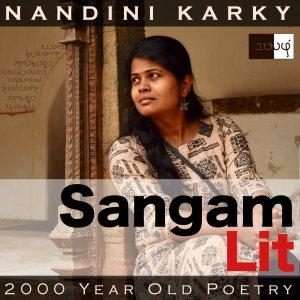Sangam Lit

Puranaanooru 380 – Strength and innocence
In this episode, we perceive the nuanced portrait of a leader, as depicted in Sangam Literary work, Puranaanooru 380, penned for the local leader Nanjil Valluvan by the poet Karuvoor Kathapillai. Set in the category of ‘Paadaan Thinai’ or ‘Praise’, the verse talks about the personality and generosity of this patron.
தென் பவ்வத்து முத்துப் பூண்டு,
வட குன்றத்துச் சாந்தம் உரீஇ,
…………………………………. கடல் தானை,
இன் இசைய விறல் வென்றி,
தென்னவர் வய மறவன்;
மிசைப் பெய்த நீர் கடல் பரந்து முத்து ஆகுந்து,
நாறு இதழ்க் குளவியொடு கூதளம் குழைய,
வேறுபெ…………………………………………………….த்துந்து,
தீம் சுளைப் பலவின் நாஞ்சில் பொருநன்;
துப்பு எதிர்ந்தோர்க்கே உள்ளாச் சேய்மையன்;
நட்பு எதிர்ந்தோர்க்கே அங்கை நண்மையன்;
வல் வேல் கந்தன் நல் இசை அல்ல,
………சிலைத்த்தார்ப் பிள்ளை அம் சிறாஅர்;
அன்னன் ஆகன்மாறே, இந் நிலம்
இலம்படு காலை ஆயினும்,
புலம்பல் போயின்று, பூத்த என் கடும்பே.
A compact song with many missing lines too. The poet’s words can be translated as follows:
“Wearing pearls from the southern seas, and smearing sandalwood paste from the northern mountains… An ocean-like army, he is the warrior-chief of the southern kings, renowned for their strength and victory. Rain that falls from above, spreads in the sea, and becomes pearls, fragrant-petaled ‘Kulavi’ flowers fuse with the ‘Koothalam’ flowers, …… Such is the country of ‘Nanjil’, densely filled with sweet clusters of jackfruit, the domain of my lord; He remains beyond reach to those who show him enmity, but to those who approach him with friendship, he becomes closer than the palms of their hands; Not only does he have the good fame of being strong like the sharp-speared ‘Kanthan’ but also… like adorable, little children who wear garlands, curving like bows; As this is his nature, even though this land entire may be filled with the suffering of poverty, there’s no reason to lament for my kith and kin, rejoicing with the blossoming of my life!”
Let’s delve into the details here. The poet begins by sketching the king’s appearance, talking about how he adorns himself with the pearls that arrive from the southern seas and the sandalwood paste that comes from the northern hills. Interpreters are divided about which mountains are being referred here. Some say, it’s the Pothigai hills, the southernmost hills of the Western Ghats in Tamilnadu, while others go as far as the Himalayas in the north. But most probably, this verse is referring to the special sandalwood called ‘Red Sanders’ found only in the Seshachalam hills, part of the Eastern Ghats, in the state of Andhra Pradesh. Today, this place is often in the news for the smuggling of this precious commodity. Possibly this same sandalwood was preferred in the ancient world too.
Returning, we find the poet mentioning about the ocean-like army of southern kings, no doubt referring to the Pandya kings, and connects that this leader is none other than the victorious commander of that army. Thankfully, without delving too much into those victories in the battlefield, bound to be gruesome, the poet starts instead talking about the natural wealth of this leader’s domain, the Nanjil country, mentioning fragrant flowers like wild jasmine and nightshade that bloom here, the sweet-tasting clusters of the jackfruit tree, and most importantly, the pearls that abound in the seas. This Sangam poet puts forth the theory that pearls form because of the rain drops that fall on the seas. The reason for this belief could be that pearls were so abundant in those seas around Pandya territory that the people then could have connected it only to the bountiful showers of the rain. This reference made me search about how a pearl is formed and I learnt that this precious creation is born because the oyster reacts to a natural irritant that enters it, so as to protect the life of the mollusc. Reminds me of the English saying, ‘When life gives you lemons, make lemonade’. Here’s an oyster making a pearl, all with a bit of annoyance that enters its life, perhaps nature’s nudge to us to face the challenges of our life with such a creativity!
Back from our meandering, we find the poet now talking about the leader’s nature, and to symbolise it, he says, to his enemies, this leader is far, far away, but to his friends, he’s like the palm of their hand, so close and approachable. Next, in strength, he’s compared to the sharp-speared Kanthan, which could be a reference to God Murugan. The poet so tastefully contrasts this fierce nature of the leader to his other side, that part of him, which is innocent and loveable like young children. He concludes with the words that even though the whole world may be in suffering and hunger, his kith and kin have nothing to worry about for this leader has showered many a golden lotus on his poet to sustain him for long. An exquisite portrayal of the country and character of this charismatic commander-in-chief of the Pandya kings!






 Visit Podcast Website
Visit Podcast Website RSS Podcast Feed
RSS Podcast Feed Subscribe
Subscribe
 Add to MyCast
Add to MyCast